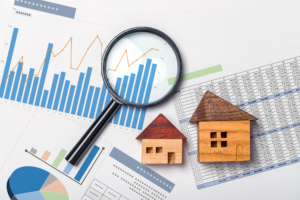Key Takeaways
- The cash rate set by the RBA has a direct impact on how banks determine home loan interest rates, particularly for variable-rate loans.
- The RBA's decision in July 2025 to maintain interest rates took many by surprise, as markets were anticipating a cut.
- As a result, home loan interest rates in Australia are likely to stay elevated for an extended period.
- Banks like ANZ predict that there will be two rate cuts in 2025, which could lead to lower home loan rates down the line.
- However, there is still uncertainty surrounding inflation and global markets that might postpone or lessen these anticipated cuts.
- Borrowers are encouraged to consult with lending experts such as Dark Horse Financial and utilise tools like home loan calculators to effectively manage their repayments.
- Predictions for home loans in 2026 are cautiously optimistic, depending on future decisions from the RBA.
As Australian borrowers moved into the second half of 2025, they were hopeful for some relief through interest rate cuts. However, on July 8, 2025, the Reserve Bank of Australia (RBA) caught many off guard by keeping the official cash rate unchanged at 3.85%, rather than implementing the expected reduction. This unexpected decision has significantly impacted the home loan market, postponing the anticipated savings for mortgage holders and creating uncertainty around home loan interest rates for the remainder of the year and into 2026.
This article explores the consequences of the RBA’s recent action, the potential for future rate cuts, and what borrowers should keep in mind while navigating their home loans in Australia during this unpredictable time.
How the RBA Cash Rate Affects Home Loan Interest Rates
The cash rate set by the Reserve Bank of Australia (RBA) serves as the key interest rate that influences loans between banks. This rate is crucial for shaping economic activity and the costs associated with borrowing. When the RBA decides to raise or lower the cash rate, banks typically adjust the interest rates on their products, such as home loans, in response.
For those with variable-rate home loans, any changes to the RBA cash rate are usually reflected in their repayments, either fully or partially. A reduction in the cash rate often leads to lower repayments, while an increase results in higher costs. On the other hand, fixed-rate home loans are not immediately affected since they lock in rates for a set period, but the fixed rates offered by lenders in the future are still influenced by what the market anticipates regarding the RBA’s future decisions.
This relationship highlights the significant role the RBA’s cash rate plays in determining how much homeowners across Australia will pay to borrow money.
Current Home Loan Landscape in Australia (July 2025)
Snapshot of Big 4 Variable and Fixed Home Loan Interest Rates (as of July 2025)
| Bank | Variable Rate p.a. | Fixed Rate p.a. |
|---|---|---|
| CommBank | 5.84% | 5.49% (3 Years) |
| Westpac [1][2] | 5.94% | 5.59% (2 Year LVR<70%) |
| NAB [1][2] | 5.94% | 5.39% (3 Years) |
| ANZ | 6.74% LVR>80% | 5.79 (3 Years LVR>80%) |

The RBA's July 2025 Decision: A Surprising Hold
The RBA’s decision to maintain the cash rate in July took many economists and borrowers by surprise. With inflation beginning to ease and consumer confidence still shaky, most analysts had anticipated a 25-basis point cut.
This decision indicates that the RBA is being cautious, waiting to ensure that inflation is truly under control before making any cuts. By holding steady, the RBA seems to be focusing on long-term economic stability rather than providing immediate relief, even if it means that households will continue to deal with higher borrowing costs.
Immediate Impact on Home Loan Interest Rates
The immediate effect of the RBA’s decision to hold interest rates is that variable home loan rates will stay the same, at least for the time being. Most lenders typically adjust their variable rates in line with the RBA cash rate, so it’s unlikely they will offer any independent rate cuts.
For those with existing mortgages, this means ongoing strain on household finances. New borrowers will continue to face the elevated borrowing costs that have been a feature of the market since rates started climbing in 2022.
Why Did the RBA Hold Rates?
According to a media release from the Reserve Bank of Australia on July 8, 2025, the Board has decided to maintain the cash rate at 3.85%. This decision comes in light of ongoing inflationary pressures and the necessity for more evidence that inflation is sustainably returning to the target range of 2–3%.
Key reasons cited in the statement include:
- Inflation Continues to Moderate: Although inflation has decreased, it is still hovering around the middle of the 2-3% range. The RBA is holding off on making cuts until there is clearer evidence that inflation is stabilising.
- Global Economic Uncertainties: Geopolitical tensions and uneven global growth contribute to a cautious approach.
- Labour Market Dynamics: The labour market remains tight, with only a slow easing observed. This situation continues to exert upward pressure on wages.
The RBA acknowledged that while inflation is heading in the right direction, the Board wants to ensure it is on a “sustained path” back to the target range before making any rate cuts. They stressed the importance of a data-driven approach moving forward, indicating that future decisions will depend on the changing economic landscape, particularly regarding inflation and labour market data.
Looking Ahead: Major Banks Predict Two Rate Cuts in 2025
Despite the RBA’s decision to hold rates steady, some major banks are still predicting interest rate cuts later this year. Economists from both ANZ and Westpac anticipate that two more cuts could happen before the year ends.
ANZ’s Adam Boyton forecasts the rate will drop to 3.35% by year-end, while Westpac’s Luci Ellis believes it could fall to 2.85%. If these cuts do take place, borrowers might experience some relief, particularly those with variable-rate home loans, potentially saving hundreds of dollars annually on their mortgages. However, the timing and probability of these cuts remain uncertain.

Home Loan Predictions 2026: What’s on the Horizon?
As we look towards 2026, the outlook for home loans appears cautiously optimistic. Many analysts anticipate that by the middle to late part of 2026, the Reserve Bank of Australia (RBA) may be able to adjust the cash rate closer to neutral, likely falling between 2.5% and 3.0%. If this scenario unfolds, borrowers might see several benefits, including:
- Reduced variable interest rates, which would provide some relief for households facing mortgage stress.
- Enhanced housing affordability, especially for those buying their first home.
- A more competitive lending landscape, as banks strive to attract new clients with more favourable rates.
However, this positive outlook hinges on various factors, such as global economic conditions, inflation trends, wage growth, and both local and international policy decisions.
Practical Advice for Borrowers in 2025
In the current environment of uncertainty, borrowers must stay proactive. Here are some strategies to consider:
1. Use Home Loan Calculator Tools
To estimate how much interest you’ll pay or how much you can save over the life of the loan, you can use several online tools, like a home loan calculator or a home loan offset calculator.
2. Consider Fixing a Portion of Your Loan
If you think interest rates are going to stay high for a while, locking in a portion of your loan could provide you with predictable costs and help stabilise your repayments.
3. Reassess Your Budget
Higher interest rates lead to increased repayments. It’s important to review your budget to accommodate any changes in your monthly mortgage costs and to adjust your discretionary spending accordingly.
4. Speak to a Mortgage Broker
A professional broker can help you find tailored loan options, access better deals, and compare home loan interest rates, especially during uncertain market conditions.
Final Thoughts
The RBA’s choice to keep interest rates steady in July 2025 has changed how people view home loan interest rates this year. Although banks like Westpac and ANZ are still predicting rate cuts, the central bank’s careful approach highlights that monetary policy relies on data and may not always match forecasts.
Borrowers need to stay alert, make well-informed choices, and utilise tools and expert advice to manage their home loans in Australia. By planning wisely and conducting regular reviews, households can navigate the ongoing fluctuations and be ready for any changes in 2026.
Secure Better Home Loan Rates
Dark Horse Financial ensures you get the best deal for your loan by securing the lowest possible rates and most favourable terms. Contact us today to learn more.
Disclaimer: The information on this page is meant to be general and should not be considered as financial, tax, or legal advice. It does not take into account your individual circumstances, goals, or needs, and should not be used as a basis for any decisions. It’s important to seek independent professional advice that is tailored to your specific situation before making any choices.



